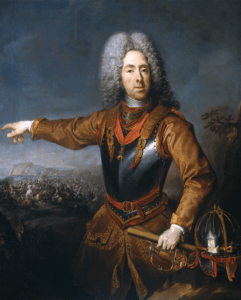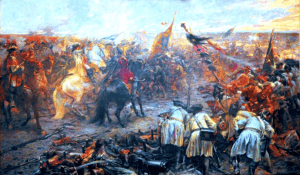
The Little Man Who Burned a City
The oil portraits don’t really do him justice. Prince Eugene of Savoy was short, even for the seventeenth century. He had buck-teeth. His nose overpowered his face, he looked sickly, and people remarked on how ugly he was.

Also, his mother was booted from France for poisoning people.
Despite his appearance and rumors of participation in raunchy cross-dressing parties, Eugene wanted a career in the military. He was sure he could be successful.
The Sun King did not agree. He vehemently did not agree. He refused to give Eugene the chance he needed to showcase his talent at leading armies.
So Eugene did what any affronted teenager who didn’t want to be shuffled off into a church career would do – he escaped France and headed to the court of the Habsburgs. His older brother had been killed fighting the Ottomans, and the Austrians agreed to give Eugene his brother’s command.
Less than two months after fleeing France, Eugene found himself on the field fighting at the Gates of Vienna, by all accounts distinguishing himself in battles enough that by the age of 22 he was made a Major-General. Throughout the Great Turkish War, he was given more and more opportunities for leadership. And, with a brief interlude needed to recover from a musket wound to his knee, at the age of 34 he was given full command of the Austrian army, which he used to absolutely crush the Ottomans at The Battle of Zenta on 11 September 1697. From this point on, Eugene of Savoy’s future as the foremost military commander in the Austrian Empire was set.

Returning from Zenta, Eugene burned his way through Bosnia as he approached Sarajevo. A month-and-a-half after the victory at Zenta, the Austrian army was overlooking the city. Prince Eugene sent in buglers and standard-bearers with the following message:
“Our warning is well intended, but we state that, should it go unheeded, and if you remain obstinate, our goodness will be twisted into severity, then we will destroy everything by sword and fire. We won’t even spare a child in its mother’s womb, for heavy artillery lies in wait.”
The city defenders killed the buglers and wounded the standard bearers as people fled the city, terrified. The Austrian army moved in to destroy the city.
Baščaršija was burned to the ground. Within Sarajevo, the Austrian army targeted mosques and Islamic Institutions, but no building that wasn’t constructed of stone was left standing. Countless books and papers were burned and lost forever.
They came and burned the beautiful city of Sarajevo down
Like cattle they drove the innocent people out
They came and burned the beautiful city of Sarajevo down
They burned Korans by the thousands and countless books
How many mosques they burned, sanctuaries pulled down!
The whole city from one end to the other, they ruined and devastated
They came and burned the beautiful city of Sarajevo down.
The effects of the sacking of Sarajevo lasted for hundreds of years. As the Austrian army left Sarajevo, 40,000 Catholic Bosnians followed for fear of retaliation; the balance of religion in the city changed forever. The aesthetics of the city changed as well – from 1697 on, buildings in the city would not be made of wood. The Sarajevo population fell precipitously, and would not regain pre-1697 levels for three hundred years.
Although the Ottomans recognized that the lack of defenses had made the sacking of Sarajevo much easier for the Austrians and contributed significant amounts to build the fortresses and walls of Vratnik, the smoking ruins proved too daunting for them to confront directly. The capital of Bosnia was moved to Travnik, where it remained until 1850.
The 150 years that Sarajevo was not the capital of Bosnia were difficult ones. Everything had to be rebuilt, and there were periods of anarchy interspersed with outbreaks of the plague. The Sacking of Sarajevo changed the face of the city as well as its history, leading to the events that would trigger the First World War.
- May 20, 2020
- Bosnia and Herzegovina
